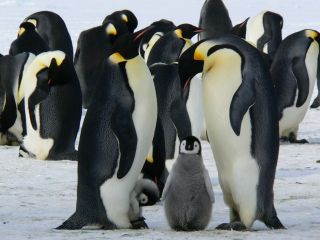Sex
Gay Penguins, Geese Thruples, and Bi-Bonobos
On romance in the animal kingdom.
Posted September 11, 2023 Reviewed by Michelle Quirk
Key points
- For decades, groups of people have castigated same-sex sexual behavior as unnatural.
- Recent research has reported evidence of sexual behavior among same-sex pairs in more than 1,500 species.
- Animals engage in these same-sex sexual behaviors for a number of potential reasons.
Once upon a time, on a sunny day at the Central Park Zoo, two penguins named Roy and Silo formed a very special bond. Shortly after meeting, zoo personnel observed the two penguins engaging in mating rituals. Despite the fact that both penguins were male, this was the beginning of a 6-year romance. The bond was so strong, that they even tried to hatch a rock as if it were an egg. Eventually, zookeepers gave them a fertilized egg that eventually hatched, resulting in the couple raising a baby penguin named Tango together.

The story, and many others like it, have become quite popular in the media—so popular that this particular romance inspired a children’s book called And Tango Makes Three. Not surprisingly, the story and the book that came with it stirred up a lot of negative attention as well, and currently And Tango Makes Three is banned in some areas of Florida. But why all the fuss over such a sweet love story? Why does the idea of two same-sex penguins engaging in romantic behavior make people so upset?
For decades, groups of people have castigated same-sex sexual behavior as unnatural. The logic is that sexual encounters between same-sex individuals cannot result in offspring, so, therefore, it cannot be natural, or something that has any evolutionary benefit. However, research suggests that sexual behavior between same-sex individuals in the animal kingdom is anything but uncommon. In fact, recent research has reported evidence of sexual behavior among same-sex pairs in more than 1,500 species, including bulls, sheep, elephants, monkeys, apes, and birds.
And there is likely more; research examining same-sex sexual behavior in animals is fairly new, as it did not become widely accepted in the scientific community until a few decades ago. Further, there are some animals—like penguins—whose sexual characteristics are internal, and it is nearly impossible to tell whether these animals are males or females without taking a look “under the hood.” So, for decades, when scientists observed these animals engaging in sexual behaviors, they just assumed that they were observing a male and a female, when, in fact, many of them were likely not.
In fact, when actually looking at who’s mating with whom, one study found that 28 percent of wild king penguins prefer same-sex partners (Pincemy et al., 2010). Same-sex sexual behavior is incredibly common even in insects, including doodle bugs and butterflies, with up to 50 percent of sexual attempts in some insect species being made toward same-sex partners (Burgevin et al., 2013). Some dolphins prefer same-sex partners as well. In fact, most male dolphins form life-long bonds only with other males, traveling with them, eating with them, and engaging in frequent sexual behavior with them, only leaving their pack to engage in sexual encounters with females to produce offspring. Even for one of our closest animal relatives—bonobos—same-sex sexual behavior is the rule, not the exception. In fact, about 60 percent of the sexual activity in bonobos happens between two females. But male-to-male sexual behavior happens in bonobos as well (Wrangham, 1993).
Monogamous sexual behavior (whether heterosexual or homosexual) isn’t the only kind of complicated sexual activity we see in the animal kingdom. Approximately 10 percent of geese raise a nest in thruples, with two males and one female; sea snails are all born male, and it isn’t until after courting that one of them will become female in order to reproduce; and coral reef fish and clown fish (yup, Finding Nemo himself) can change their sex if needed by their school (Schrefer, 2022).
You, like many scientists and skeptics, might be asking, why do animals engage in these behaviors if they don’t lead to reproduction? Shouldn’t evolution have nipped this in the bud? First of all, there are cases where more attempts at sex—regardless of whether those attempts are directed toward same- or opposite-sex partners—end up leading to more offspring (Burgevin et al., 2013). Second, the adaptive value of sexual behavior isn’t always just to reproduce. In animals like bonobos and dolphins, for example, same-sex sexual behavior can function to help social bonding or in forming alliances (Schrefer, 2022). Finally, sometimes animals likely engage in sexual behavior because it just feels good. When you think of human beings, there are lots of sexual activities humans engage in (again, heterosexual and homosexual alike) that can’t result in reproduction; we just do it because it feels good. In fact, we do lots of things that are bad for our survival all the time because they feel good, like eating cheeseburgers, smoking, having a few beers, or watching TV instead of exercising.
The point is, homosexual behavior is quite natural in the animal kingdom. Further, arguments that homosexuality in humans is “unnatural” ignores the fact that the same behaviors are quite the norm in monkeys, dolphins, penguins, and even insects. The bottom line is that scientific exploration in this area, especially in animals, is only just beginning. But, so far, the science is clear: Sexual behavior isn’t so straightforward—in any species.
References
Burgevin, L., Friberg, U., & Maklakov, A. A. (2013). Intersexual correlation for same-sex sexual behaviour in an insect. Animal Behaviour, 85(4), 759–762.
Pincemy, G., Dobson, F. S., & Jouventin, P. (2010). Homosexual mating displays in penguins. Ethology, 116(12), 1210–1216.
Schrefer, E. (2022). Queer Ducks (and Other Animals): The Natural World of Animal Sexuality. Katherine Tegen Books.
Wrangham, R. W. (1993). The evolution of sexuality in chimpanzees and bonobos. Human Nature, 4, 47–79.


